| | Factsheet topics | Adaptation | Floral inducation and initiation | Marketing | Varieties | Field selection | Establishment | Fertility on established stands | Pest management | Harvesting | Post harvest management | Removing timothy stands
Timothy seed is used primarily in mixes for hay, pasture or silage. It is also used in solid stands for the hay compaction industry. Most seed produced in Western Canada is used in North America; however, some proprietary varieties are grown under contract and shipped overseas, mainly to Europe.
Manitoba is the main timothy seed production area in Canada. In Alberta, timothy seed is produced primarily in the Peace River region and, to a lesser extent, in the St. Paul and Edmonton areas. There are also a number of fields located in northern Saskatchewan. In the US, 75 per cent of the US seed production is in Minnesota, with the rest of the production concentrated in five other states.
As timothy readily produces seed, pure timothy hay stands can be harvested for seed, while in years of hay shortages, seed fields may be harvested for fodder (Figure 1).
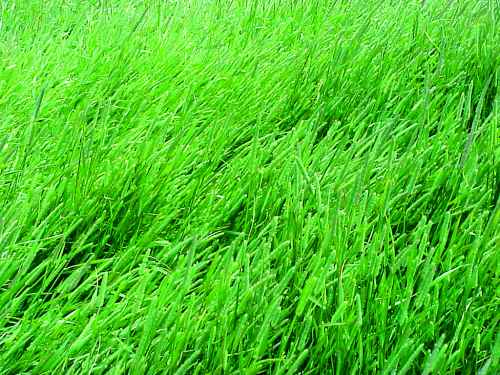
Figure 1. Timothy seed field.
Factsheet Topics
- Adaptation
- Floral induction and initiation
- Marketing
- Varieties
- Field selection
- Establishment
- Fertilizing
- Pest management
- Harvesting
- Post harvest management
- Removing timothy stands
Adaptation
Phleum pratense L., timothy, is a medium-lived, cool-season perennial bunchgrass with a shallow, fibrous root system. It is winter hardy and persistent in the cooler and moister areas of Canada. It does well on waterlogged and peat soils, but also grows well on clay, silty or sandy soils, where moisture is adequate. Timothy is best suited to the Black and Gray Wooded soil zones and irrigated areas.
Timothy can withstand some spring flooding. Moisture in the spring and early summer is necessary to produce a high yielding timothy seed crop. The grass is adapted to soils with a pH ranging from 4.5 to 7.8. Timothy is intolerant of salinity and alkalinity.
Timothy seed is small in comparison to most other common grass species. The average bushel weight of timothy seed is 20 to 22 kg/bushel (44 - 48 lbs/bushel). The small dense seeds (2.64 million seeds/kg) can make several operations difficult: calibrating seed drills, seeding at the proper depth and combining.
Timothy seed yields can vary greatly because of factors such as the variety, location, management, moisture conditions and harvest conditions. The long-term average yield of timothy in western Canada is 250 to 300 kg/ha, but yields can range from 100 to 600 kg/ha.
Floral Induction and Initiation
Most perennial cool-season grasses go through several stages in their floral induction and initiation. Initially, after the seed germinates, there is a vegetative or juvenile stage during which the growing points of the grass develop into leaves and stems. These growing points grow vegetatively through spring and summer.
In the fall or early winter, there is a response to low temperatures (vernalization) and/or day length (short day). This response induces a tiller to become reproductive. This stage is called primary induction.
Many factors affect the induction process:
- plant age
- species
- variety
- nitrogen fertility
- planting date
- date of tiller formation
- clipping or grazing
- stage of plant development
- plant spacing
- temperature
Secondary induction or floral initiation is the next stage. This stage is affected by timing and environmental requirements. Many cool season grasses require warm temperatures and long days in the spring for floral initiation and development of the seed head.
Timothy requires long days for floral induction, but without a cold/short day requirement. Therefore, timothy does not have a winter requirement for flowering and, if conditions are favorable, plants will flower in the year of seeding.
The length of photoperiod required for floral induction and heading in timothy will vary depending on the cultivar and its origin. Timothy cultivars from higher latitudes generally have longer photoperiodic requirements than those developed in lower latitudes. As well, higher temperatures can inhibit floral initiation and heading in cultivars requiring longer photoperiods.
Following floral initiation, the seed head develops. Heading dates in timothy can vary among cultivars by as much as three weeks or more. The growth, and subsequent development, of the entire inflorescence and spikelets is indeterminate, so some florets will be fully developed and others will be empty or sterile.
Anthesis occurs once the flowers have developed completely, and pollen is released from the anthers and carried by the wind. Anther exertion in timothy is influenced by weather conditions occurring the previous day. The release of pollen in timothy occurs at night and generally lasts for six to eight days.
The main factors affecting anthesis are temperature and relative humidity. Night temperatures greater than 10°C cause the earlier onset and shorter duration of anthesis. Lower night temperatures decrease both flowering intensity and the number of flowers that open at peak anthesis. High temperatures can cause blasting and poor seed set.
Rainfall can have a negative affect on anthesis by causing an earlier and shorter duration of anthesis during the day; however, wet weather can extend the total time of anthesis.
Marketing
Long-term prices
The price of timothy seed is affected by the market demand in the US, Europe and Canada and the supply from the seed production areas in western Canada. The price for common seed can be readily affected by the hay compaction industry because, in years when weather conditions are not suitable for hay production, many of the fields can be harvested for seed. Figure 2 shows the average price of common timothy seed for the past
23 years.
A comparison between the price of certified and common timothy seed for the past six years is shown in Figure 3. The difference between the common and certified price of timothy seed is narrow when supplies are limited, and wide when there are abundant supplies. The certified price is based on Climax timothy.

Figure 2. Average price of common timothy seed to the grower, 1970-2003.
(Yearly price based on monthly phone calls to various seed buyers and averaged for the year: Alberta Agriculture, Food and Rural Development (AAFRD))

Figure 3. Average price of common vs. certified timothy seed to the grower, 1996-2003.
(Yearly price based on monthly phone calls to various seed buyers and averaged for the year: AAFRD)
Marketing options
A producer marketing timothy seed has two options:
1) selling into the cash market, or 2) contracting the crop. Companies will offer a number of alternatives within these two marketing methods.
Seed companies will generally offer two contracting options, forward priced or production contracts. Forward pricing is a contract where the grower agrees to deliver a specified amount of seed, of a certain grade, on a specified date either FOB the farm or seed plant to a seed company. In return, the seed company agrees to pay a certain price based upon grade and quality. The price for the seed may be 100 per cent "fixed" or a portion fixed at price "X," with the remaining price determined at the time of delivery.
A production contract is an agreement signed between a seed company and a grower where the grower agrees to produce seed of a specific variety or from a specific land area. The seed is sold to the company at a specified price (can be the set price at time of delivery) as long as the seed meets quality standards outlined in the contract. If the seed does not meet the standards as outlined, the price to the grower can be substantially reduced.
Most production contracts are for certified production. (Note: if US varieties are grown, seed may be of foundation, registered or even certified origin). Field inspection is normally required for the certified production of varieties.
Growing timothy under contract with a guaranteed minimum price reduces the price volatility in the marketplace. Many contracts for proprietary varieties are based on Climax. The price received on those contracts may change from year to year, as there are annual price fluctuations of Climax timothy.
It is very important for producers to fully understand the contract before signing. Seed not meeting the grade specified in the contract may be purchased at a discounted price. Contracts will vary among seed companies.
Certified versus common production
A producer can grow either common timothy or obtain foundation seed of a registered variety. In common seed production, the harvested seed is cleaned and tested for purity and germination, tagged as "common timothy" and sold as such. The grower can sell common seed off his own farm, market it through a broker or sell it to a seed company. The producer cannot advertise common seed as "grown" from a particular variety.
Only foundation seed can be sown for production of Canadian certified varieties. Tags of the original foundation seed must be kept, and the grower must apply for field inspection through the Canadian Seed Growers Association (CSGA) and the Canadian Food Inspection Agency (CFIA).
If the crop meets CSGA standards following inspection and cleaning, crop certification is assigned to the crop providing the crop certification information (variety, lot number, etc.). The seed can then be marketed as "Certified."
Quality
The price received by the grower for his timothy seed is determined by the quality of the seed. Quality is evaluated in terms of weed seed contamination, germination and purity. Specific weed seeds can be a problem depending on the destination and end use of the final product.
Weed infestations in seed fields can reduce revenue in two ways. First, weeds can reduce seed yield through competition and dockage. Second, weeds can reduce the price because of the presence of inseparable weeds seeds.
Weed seed contaminants that reduce the grade of timothy are clovers, Canada thistle, toadflax, cleavers, stinkweed, white cockle, scentless chamomile and night-flowering catchfly. Growers must be especially aware of weeds that lead to grade reductions and discounts on the seed produced for both domestic and foreign markets. Seed processors cannot clean out all types of weed seed, particularly those similar in size, shape and weight to the timothy seed.
Varieties
The standard variety grown in Canada is Climax, a public variety developed by Agriculture and Agri-Food Canada. Climax is distributed and sold to growers and seed companies through the Canadian Forage Seed Project. Applications to purchase seed directly from the Canadian Forage Seed Project must be submitted by December 31 of each year.
There are many proprietary timothy varieties grown under contract for seed companies. These varieties are used domestically or exported to European countries or the US.
Selecting a variety will depend on whether the seed produced will be pedigreed or common, a public or proprietary variety and the seed yield potential (Figure 4).
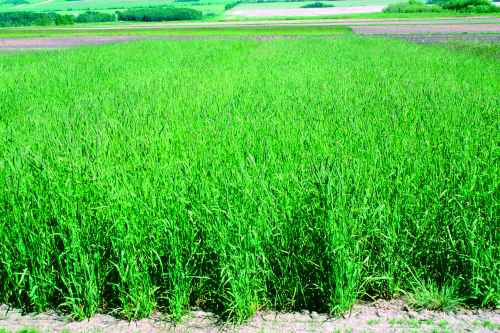
Figure 4. Timothy seed variety trial.
Photo courtesy of Nigel Fariey, Agriculture and Agri-Food Canada
It is important to discuss marketing opportunities with local seed companies before deciding on a variety. Yield potential will vary among varieties. Before purchasing seed, ask for a seed certificate from the supplier. Examine the information on the certificate, paying particular attention to the types and number of weed seeds, regardless of the grade.
Seed yield data for the different varieties can be limited. Information is available from local seed companies, local forage extension specialists, the Agriculture and Agri-Food Canada Station at Beaverlodge and through the Western Canadian Grass Seed Testing Program at the website: http://www1.agric.gov.ab.ca/$department/deptdocs.nsf/all/for7820?opendocument
Table 1 below shows a list of several timothy varieties tested for seed production by Agriculture and Agri-Food Canada in the Peace River Region.
Table 1. Timothy varieties tested for seed production by Agriculture and Agri-Food Canada in the Peace River Region
Timothy variety | Number of site
years tested | Seed yield as
% of Climax |
| Alma | 4 | 181 |
| Basho | 23 | 62 |
| Bottnia II | 29 | 187 |
| Bounty | 14 | 81 |
| Champ | 14 | 84 |
| Climax | 43 | 100 |
| Comtal | 4 | 125 |
| Hokuo | 10 | 83 |
| Itasca | 15 | 88 |
| Rasant | 25 | 174 |
| Richmond | 22 | 104 |
| Tiiti | 19 | 205 |
| Tiller | 4 | 89 |
| Timfor | 10 | 86 |
| Climax (yield in kg/ha) | 43 | 254 |
(Forage Cultivar Trials - 1988, Northern Research Group)
Field Selection
Pedigreed requirements
When growing pedigreed seed (Breeder, Foundation and Certified), a number of requirements must be considered before selecting a field. The two main requirements cover previous crop history and the isolation distance from other timothy varieties.
Growers are advised to refer to the Canadian Seed Growers Association (CSGA) Handbook Regulations and Procedures for Pedigreed Seed Crop Production CSGA Circular 6-94 for details on specific requirements.
Weeds
Timothy must be established in fields free of perennial weeds and other volunteer grass crops. Quackgrass, clovers, Canada thistle, foxtail barley, toadflax and dandelion are perennial weeds that can be controlled before seeding.
Annual or winter annual weeds, including volunteer canola, redroot pigweed, cleavers, chickweed, narrow-leaved hawks-beard, stinkweed, white cockle, corn spurry, scentless chamomile and night-flowering catchfly, are difficult to remove by cleaning. The grower seed price will be reduced if quality requirements are not met.
Most perennial weed problems can be managed by applying glyphosate pre-harvest or post-harvest in annual cropping rotations for several consecutive years before planting timothy. Heavily weed-infested fields should not be used for establishing timothy for seed.
Herbicide residues
It is important to know the cropping history and associated cultural practices of the site. Previously applied residual herbicides can seriously affect grass seedlings. Table 2 outlines herbicide residues that may be of concern when seeding timothy. The amount of herbicide residues will vary depending on the soil type, moisture, organic matter and pH.
To avoid problems, read the herbicide label for current, detailed information on grass cropping restrictions. Keep detailed field records and plan crops to avoid seeding timothy into soils with injurious levels of herbicide residues (Figure 5). Before leasing or purchasing land, obtain a record of the herbicides used during the past five years. The lease should also include a statement regarding liability if a herbicide residue is found.
Table 2. Timothy cropping restrictions for currently used herbicides.
| Herbicides | Grass cropping restrictions |
Absolute
Ally
Assert
Escort
Muster
Muster Gold
Odyssey
Prism
Pursuit
Pursuit Ultra
Unity | Seedling timothy may be affected for one or more years after application. Conduct a field bioassay (a test strip grown to maturity) the year before planting timothy. The yield from the test strip should be compared to the yield from an adjacent untreated area. |
Atrazine/Laddok
Primextra II Magnum
Princep Nine-T | May cause severe injury to timothy one or more years after application. |
| Banvel II | Timothy may be affected if high rates of Banvel II were used for perennial weed control the previous year. |
Edge
Fortress
Treflan/Rival/Bonanza/Advance/Heritage | Timothy should not be grown in rotation following a treated crop. High application rate caused by overlapping, improper calibration and non-uniform application may reduce timothy stands that follow in rotation. Drought conditions in the year of treatment may result in higher levels of carryover into the next year. |
| Sencor | Timothy should not be grown for 24 months following application on irrigated alfalfa. |
Sundance
Everest
K2 | Do not plant for at least 22 months following application. A field bioassay must be conducted the year prior to planting timothy to confirm crop safety. |
| Tordon 22K | When applied as a spot treatment on cropland, Tordon 22K may persist in the soil for up to five years and prevent the establishment of timothy in these spots. Manure from Tordon 22K-treated vegetation should not be used to grow sensitive crops such as timothy. It should be applied to a cereal crop field. |
| Velpar | Seeding a field bioassay is not recommended less than 24 months after the last Velpar application. |
(Crop Protection Agdex 606-1, Alberta Agriculture, Food and Rural Development)
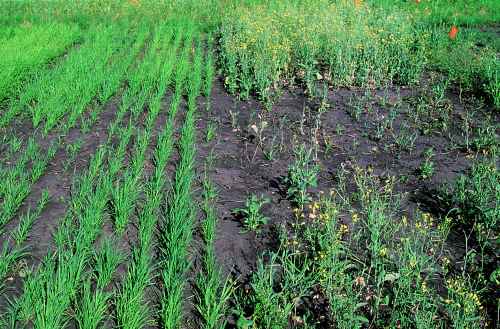
Figure 5. Herbicide residue affecting the establishment of timothy plants.
Establishment
Seedbed preparation and seeding depth
A fine, firm seedbed is the key to successful timothy establishment with a zone of 5 to 8 cm free of large lumps and air pockets. When a seedbed is properly packed, tractor tire marks will be barely visible.
A firm seedbed allows for a shallow, uniform seeding depth and ensures the seed has close contact with soil moisture, resulting in rapid germination and early seedling root growth. Seedbed preparation in the previous fall or very early in the spring promotes the germination of some weed seeds and reduces soil moisture losses from excessive cultivation.
Timothy and the companion crop can be seeded one to two weeks after the last spring cultivation and sprayed with a glyphosate product before seedling emergence. Direct seeding into crop stubble also works well (Figure 6).
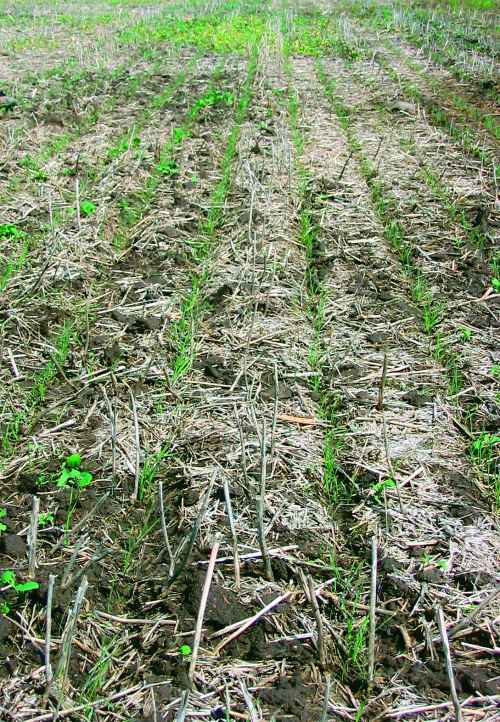
Figure 6. Direct seeding timothy into canola stubble is an excellent method for establishing timothy.
The optimum seeding depth is from 0.65 to 1.25 cm (0.25 - 0.50 inch) (Figure 7). Research has shown that only 50 per cent of the seeds will germinate at 3.75 cm (1.5 inch) depth, and only 10 per cent of the seeds will germinate at a 7.5 cm (3 inch) depth. Timothy has high seedling aggressiveness and persistence once established.
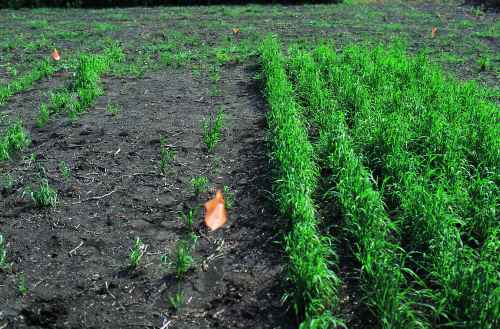
Figure 7. Effect of seeding depth on timothy the year after seeding (left to right: 2.5 cm vs 1.25 cm).
Seeding dates
Timothy should be sown as early as possible in the spring. First year seed yields will be reduced when timothy is seeded after mid-June (Table 3). Timothy will tolerate late seeding under excellent soil moisture conditions when established without a companion crop. Good snow cover is required for the survival of seedling timothy if it only reaches the two-leaf stage before winter.
Table 3. Effect of seeding dates on timothy seed yields, Beaverlodge Alberta 1969-1972
| Seeding date | Range of seed yields (kg/ha)
on first harvest | Average seed yields (kg/ha) based
on 15 harvests from 4 seeding years |
| Before May 15 | 116 - 629 | 356 |
| May 16 - 31 | 141 - 685 | 394 |
| June 1 - 15 | 140 - 777 | 394 |
| June 16 - 30 | 108 - 869 | 384 |
| July 1 - 15 | 124 - 454 | 347 |
| July 16 - 31 | 84 - 345 | 357 |
| August 1 - 15 | 43 - 227 | 345 |
| August 16 - 31 | 1 - 158 | 340 |
| September 1 - 15 | 1 - 113 | 318 |
| September 16 - 30 | 0 - 113 | 315 |
| After October 1 | 0 - 24 | 276 |
Row spacing
Although broadcasting timothy seed is commonly used, timothy can be seeded in row spacings of 20 to 30 cm. Some studies have shown slight seed yield increases when seeded up to 40 cm row spacings (Table 4). The invasion of weeds is reduced when timothy is seeded in narrow rows. Wider row spacings can be beneficial in drier areas.
Table 4. Effect of row spacing on yearly timothy seed yields (kg/ha) averaged over four years, Beaverlodge Alberta 1972-1977
| Row spacing (cm) | 1972 seeding | 1973 seeding | Average of 8 harvest years |
| 20 | 347 | 358 | 352 |
| 40 | 392 | 345 | 369 |
| 60 | 366 | 321 | 343 |
| 80 | 287 | 253 | 270 |
| 100 | 242 | 244 | 243 |
Seeding rates
A seeding rate of 1.1 to 2.2 kg/ha (1 to 2 lbs/ac) usually provides a good stand. Because of its small seed size, timothy seeded at 2.2 kg/ha will have 26 seeds per 30 cm of drill row in 15 cm spacings, and 52 seeds per 30 cm of drill row in 30 cm row spacings. Higher seeding rates are used when seeding with a companion crop or where establishment has been unsuccessful in the past.
Companion crops
Seeding without a companion crop is the preferred method, although timothy is one of the forage species least affected by under seeding to an annual crop. However, companion crops compete with timothy seedlings, resulting in reduced stands and lower seed yields the following year (Figure 8). If a companion crop is used, seed it at half the normal rate, and fertilize using reduced nitrogen levels.
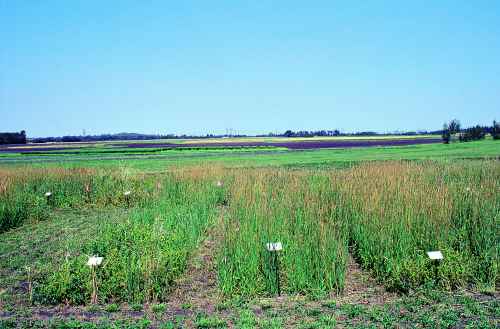
Figure 8. Timothy establishment the year after seeding when timothy was seeded alone (left),
timothy seeded with oats harvested for silage (middle) and oats harvested for grain (right).
Removing the crop as green feed or silage provides better timothy establishment than harvesting the crop for grain. If the crop is harvested as grain, ensure straw and chaff are spread uniformly across the field to avoid smothering timothy seedlings. Barley, wheat and oats have been used as companion crops for timothy.
Selecting an early maturing cereal variety will help reduce the effects of the companion crop on timothy seedlings. Canola and flax have worked well as companion crops and, in most cases, better than cereals, but the herbicide options are very limited. It is very important to know the herbicide options for both the annual crop and the timothy when seeded together.
Seeding without a companion crop
Timothy can be seeded successfully without a companion crop. It is very important to use practices that ensure the crop emerges quickly after seeding and has an opportunity to develop throughout the summer and fall with minimal competition from weeds.
When seeding timothy without a companion crop, avoid fields seeded to cereals the previous year. Volunteer cereals are competitive with developing seedlings and can be difficult to control.
Prepare a firm, well-packed seedbed to ensure the seed can be placed shallowly and evenly across the field. Direct seeding into canola or pea stubble works well. Using a glyphosate product before and/or after seeding, but before seedling emergence, is a cheap and effective method of weed control. Table 5 shows the benefit of applying glyphosate before or shortly after direct seeding timothy to remove early weed competition.
Table 5. Timothy forage yields in September of the establishment year
| Timing of glyphosate application | Timothy forage yield % of untreated check |
| .. | Beaverlodge | Edmonton |
| Within 5 days before seeding | 197 | 87 |
| Within 5 days after seeding | 205 | 214 |
(Following pre-seeding and pre-emergent applications of 1 L/acre of glyphosate (360 g/L) when direct seeding timothy at Beaverlodge and Edmonton, 2003)
A number of herbicides are available to control broadleaf weeds in seedling timothy stands seeded without a companion crop, but there are very few options for controlling grass weeds such as wild oats and volunteer cereals. Wick applicators can be used to control grassy weeds by applying a 33 per cent solution of a glyphosate product when the weeds are taller than the seedling timothy. Generally, two passes are made in opposite directions across the field.
One or two mowings may also be required during the establishment year. Ensure that mowed weeds do not smother the small timothy seedlings, especially under moist conditions. Controlling weeds is critical for the successful establishment of timothy when seeded without a companion crop.
Fertility during establishment
Fields should be soil tested before seeding timothy to determine soil nutrient levels. Low rates of fertilizer can be placed with the seed at the time of seeding.
Phosphorous at rates up to 15 kg/ha can be safely placed with the seed. If higher amounts of phosphorous are required, it can be broadcast and incorporated or banded into the soil before planting. Phosphorous deficiencies can be corrected by broadcasting phosphorous fertilizer once the stand is established.
The use of seed placed-nitrogen should be minimal, as seedling emergence has been reduced by 30 per cent when nitrogen was applied at a rate of 30 kg/ha (Table 6).
Table 6. Effects of seed-placed nitrogen on timothy emergence
| Rate of nitrogen kg/ha | Seedling emergence as% of check |
| . | Urea (46-0-0) | Ammonium nitrate (34-0-0) |
| 0 | 100 | 100 |
| 30 | 65 | 70 |
| 60 | 36 | 40 |
| 120 | 0 | 0 |
| 120* | 96 | 102 |
* Nitrogen fertilizer was broadcast and worked to a depth of 5 cm before seeding.
Bailey, L.D. Brandon Research Station Report.
Herbicides on seedling timothy
A number of products are registered for use on seedling timothy stands. A seedling is defined as a plant within three months of emergence. Herbicide applications are usually recommended at the 2 to 4 leaf stage of seedling grasses although if weed pressure is high, herbicides may be applied earlier.
Herbicide selection is based on several criteria: the weeds present, the effectiveness of the herbicide on these weeds, the tolerance of seedling timothy to the herbicide, the tolerance of the companion crop and the cost of the herbicide.
Developing timothy seedlings are poor competitors. Therefore, it is essential to keep weed competition to a minimum by eliminating weeds early. Table 7 provides information on the relative tolerance of seedling timothy to several herbicides. Only herbicides that are registered can be recommended for use.
Table 7. The effect of herbicides on seedling timothy (2 to 4 leaf stage)
| Currently registered (February 2004) | Potential for a minor use registration | May cause severe injury |
| Avenge* | Attain | Ally |
| Banvel
(alone or with 2,4-D) | Curtail M | Assure II |
| Basagran | DyVel DS | Assert |
| Buctril M | Frontline | Edge |
| Embutox** | Prestige | Fusion |
| Lontrel | Refine Extra | Hoe-Grass 284 |
| Pardner | Spectrum | Horizon |
| MCPA | . | Odyssey |
| Target** | . | Puma Super |
| Tropotox Plus | . | Pursuit |
| 2,4-D | . | Pursuit Ultra |
| . | . | Poast Ultra |
| . | . | Select |
| . | . | Sencor |
| . | . | Sundance |
| . | . | Treflan/Rival |
| . | . | Triumph Plus |
| . | . | Venture |
* Underseeded to wheat or barley. There may be injury especially under adverse growth conditions.
** Registered for forage production.
For information only. From Expert Committee on Weeds Research Report Western Section, 1971-98.
Annual grassy weeds such as wild oats, green foxtail, barnyard grass and Persian darnel are very difficult to control with herbicides, in seedling or established timothy. Timothy is very sensitive to most grassy weed herbicides (Figure 9), and Achieve Liquid does not have seedling or established timothy on its label.
There are also no herbicide options for the selective control of volunteer cereals such as wheat, barley and oats in seedling or established timothy. This situation underlines the importance of managing annual and perennial grassy weeds and volunteer cereals before attempting to establish a timothy stand.
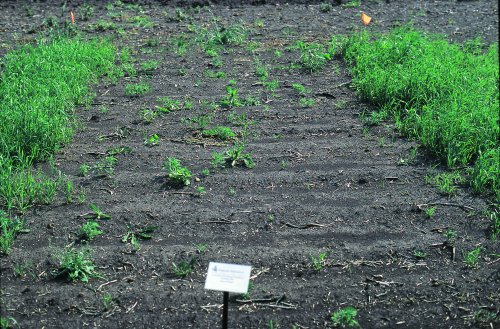
Figure 9. Seedling timothy is extremely sensitive to wild oat herbicides such as Puma Super.
Fertility on Established Stands
Timing of application
Floral initiation in timothy has specific timing requirements for nitrogen. Because timothy initiates floral parts in the spring, which is later than most other grass species, nitrogen timing is also later.
The preferred dates for fertilizing are either late fall (mid to late October) or early spring (mid to late April) before any re-growth starts. Broadcasting is the main method of fertilizer application on established timothy stands.
Types and rates of fertilizer
Timothy has a high requirement for nitrogen fertilizer. Rates of nitrogen applied to timothy stands typically range from 60 to 100 kg/ha depending on soil fertility status, soil moisture conditions and age of stand.
Producers wanting optimum yields should be applying nitrogen rates of at least 80 kg/ha (Table 8 and 9). Older stands will require higher levels of nitrogen. It is not uncommon to fertilize 3 or 4-year-old stands with 80 to 100 kg/ha of nitrogen (Figure 10).
Table 8. Timothy seed yield response to increasing rates of broadcast nitrogen fertilizer applied with 20 kg/ha of phosphorous fertilizer
| Nitrogen fertilizer (kg/ha) | Timothy seed yield (kg/ha) |
| 0 | 125 |
| 50 | 256 |
| 100 | 258 |
| 150 | 271 |
(7 site years in northeastern Saskatchewan) - Can. J. Soil Sci. 79:265-271.

Figure 10. Timothy seed crops show large responses to nitrogen fertilizer.
Table 9 shows results from a three-year trial comparing rates of nitrogen fertilizer on timothy seed yields in Manitoba. The fertilizer was applied in the spring in the form of ammonium-nitrate. In this trial, an annual application of 85 kg/ha of nitrogen resulted in the best timothy seed yields. Increasing the rate appeared to hurt yields by promoting excessive vegetative growth.
Table 9. Effect of rates of spring applied nitrogen on timothy seed yields, Arborg Manitoba 1989-1991
| . | Seed yields kg/ha |
| Rate of nitrogen kg/ha | 1989 | 1990 | 1991 | Average of years |
| 0 | 109 a | 63 a | 44 a | 72 |
| 55 | 377 b | 383 b | 205 b | 322 |
| 85 | 466 b | 498 c | 227 b | 397 |
| 112 | 393 b | 456 bc | 246 b | 365 |
| 140 | 410 b | 344 b | ...-- | 377 |
| 196 | 361 bc | 242 b | ....- | 302 |
Means followed by the same letter are not statistically different at P = 0.05. Duncans Multiple Range Test.
Other nutrients such as phosphorus, potassium and sulphur may be required, particularly as the stand ages. Soil testing is useful to determine which nutrients may be limiting seed yields. Timothy stands are generally left in production for a minimum of four or five years, which means large amounts of nutrients are removed from the soil.
Seed yield responses of grasses to phosphorus fertilizer are correlated to the amounts of phosphorus present in the soil. Research trials in Saskatchewan have shown an increase in yield from broadcast phosphate fertilizer where soil tests indicated low levels of phosphorus (Table 10).
Table 10. Timothy seed yield response to broadcast phosphate fertilizer at 50 kg/ha of nitrogen
| Phosphate fertilizer - P2O5 (kg/ha) | Timothy seed yield (kg/ha) |
| 0 | 225 |
| 20 | 256 |
| 40 | 266 |
(7 site years in northeastern Saskatchewan) - Can. J. Soil Sci. 79:265-271.
Sulphur deficiencies can be corrected quickly by applying a sulphate-based fertilizer. Elemental sulphur fertilizers can also be used on timothy stands as long as they are broadcast and left on the soil surface. There is a one-year lag period before sulphate from elemental sulphur is available to the crop.
Form of nitrogen fertilizer
Care must be taken in deciding what form of nitrogen to use since most of the fertilizer applied to timothy stands is broadcast. Ammonium nitrate (34-0-0) is recommended over urea (46-0-0) for broadcasting since urea has a greater potential for losses through gassing off (volatilization). Urea can be an effective source of nitrogen for timothy if the fertilizer is broadcast early in the spring before soil/thatch temperatures rise above 10°C.
Conditions favorable to urea fertilizer use are a dry, unfrozen surface with rainfall or snow occurring shortly after application. Rainfall is required to move urea into the soil and prevent losses to the air. Some producers will apply urea on top of several inches of snow when the ground is not frozen and the snow is expected to melt.
The risk of nitrogen losses when using urea is greatest with soils that are warm, high in pH and sandy. Urea losses can also be high when there are high winds, high levels of surface residues, wet soil surfaces and soil temperatures above 10°C.
Nitrogen losses can occur with runoff in the spring if fertilizer is applied on top of frozen ground covered with more than 4 inches of snow. This cover prevents the fertilizer from moving into the soil, making it susceptible to runoff in the spring. Banding nitrogen fertilizer using narrow openers has been used successfully, but there is risk of stimulating weed growth due to soil disturbance.
Pest Management
Weed control in established stands
Producing a seed crop free of weed seeds is a function of several factors: how clean the field was of perennial weeds before seeding, stand establishment, row spacing, fertility, combine settings and the choice of in-crop herbicides.
The Agriculture and Agri-Food Canada Research Station at Beaverlodge has conducted research on the effect of herbicides applied on timothy at varying stages of growth. The results showed that extreme caution must be used when applying herbicides to timothy.
Applications of 2,4-D in the fall of the year of seeding severely reduced timothy seed yields the following year. The application of 2,4-D in the spring before stem elongation also reduced seed yields. Applications of 2,4-D at the shot blade stage appear to be safer than those made before stem elongation (Table 11), and 2,4-D applied in the fall after the first seed crop is harvested appears to be safe. The use of Banvel or products containing Banvel are not be recommended on established timothy grown for seed.
Table 11. Tolerance of established timothy to2,4-D ester (600 LV) and Banvel applied at several different growth stages
| Application information | .. | .. | Reduction in yield of first crop after treatment | .. |
| Year | Date | Stage of crop | 2,4-D 400 ml/ac | Banvel 118 ml/ac |
| 1 | June | Crop planted | . | . |
| . | July | 3-leaf | Nil | Nil |
| . | Sept. | . | 46 - 48% | 0 - 22% |
| 2 | May | Before stem elongation | 16 - 25% | 24 - 51% |
| . | June | Shot-blade | 0 - 6% | 33 - 73% |
| . | . | Early heading | 0% | 52% |
Experiments in Control of Weeds in Grass Seed Crops, 1971-1996, Darwent and Drabble.
Established timothy is very sensitive to most herbicide applications, especially if it is under stress. Herbicide selection will depend on the weeds present, tolerance of the timothy, stage of the timothy, health of the timothy, cost and rotation of herbicide groups.
Some damage from herbicide application may be acceptable to a producer if troublesome weeds are controlled to prevent a loss of grade. Tables 12 and 13 provide information on the tolerance of established timothy to a number of broadleaf herbicides and grassy weed herbicides. The higher the number of trial sites, the more confidence can be put in the seed yield information provided.
Table 12. Seed yields after spraying established timothy with various broadleaf herbicides in the spring
| Herbicide | Average % seed yield of untreated check |
| . | 1 x recommended rate of the herbicide | 2 x recommended rate of the herbicide |
| Lontrel | 95 (1) | 87 (1) |
| MCPA amine | 87 (2) | . |
| MCPA amine + Lontrel | 93 (8) | . |
| Curtail M | 85 (8) | 78 (8) |
| Prestige | 81 (8) | 78 (8) |
| Spectrum | 84 (7) | 82 (5) |
| Fluroxypyr | 97 (4) | . |
| Ally | 84 (8) | 58 (2) |
| Banvel | 46 (4) | 32 (4) |
| Banvel + 2,4-D | 56 (3) | .. |
| Buctril M | 96 (2) | 71 (1) |
| Estaprop | 79 (2) | 67 (1) |
| Target | 76 (4) | 71 (2) |
| 2,4-D ester | 85 (4) | 77 (3) |
( ) is the number of trial sites used in the average yield.
Table 13. Seed yields after spraying established timothy with various grassy weed herbicides applied in the spring
| Herbicide | Average % seed yield of untreated check |
| . | 1 x recommended rate of the herbicide | 2 x recommended rate of the herbicide |
| Achieve DG | 83 (10) | 71 (6) |
| Assert | 50 (5) | 34 (5) |
| Avenge | 85 (9) | 82 (8) |
| Hoe-Grass 284 | 57 (9) | 40 (8) |
| Puma Super | 32 (5) | 20 (5) |
( ) is the number of trial sites used in the average yield.
Table 14 lists the herbicides currently registered for use on established timothy, the herbicides causing slight to moderate damage and the herbicides causing severe injury to established timothy applied in the spring before the shot blade stage. Only herbicides that are registered can be recommended for use.
Table 14. Herbicides applied in the spring on established timothy
| Currently registered | Potential for a minor use registration (slight to moderate damage) | May cause severe injury |
| Buctril M | Ally | Assure II |
| Lontrel | Avenge | Assert |
| MCPA | Curtail M | Banvel |
| . | Estaprop | Hoe-Grass 284 |
| . | Frontline | Horizon |
| . | . | Odyssey |
| . | Pardner | Poast Ultra |
| . | Prestige | Puma Super |
| . | Spectrum | Pursuit |
| . | . | Refine Extra |
| . | . | Sundance |
For information only. From Expert Committee on Weeds Research Report Western Section, 1971-98.
It should be noted that amine formulations of phenoxy herbicides such as 2,4-D or MCPA may cause less injury to timothy than the ester formulations. A tank mix of MCPA amine+Lontrel is one of the safer treatments to apply on established timothy fields in the spring to control weeds such as volunteer clovers, thistles and dandelions.
Trials conducted at Beaverlodge and Ellerslie, Alberta, have shown fall spraying of established timothy fields (mid-September) with products such as Ally or Prestige has good potential to control perennial weeds, such as dandelions and clovers as well as winter annual weeds, such as narrow-leaved hawk's-beard, without causing reductions in seed or forage yields the following year. The application of Ally on established timothy in the spring results in damage, but fall applications appear to be safe (Table 15).
Table 15. Average per cent timothy seed yield of untreated check between spring and
fall applications of herbicides
| Herbicide treatment | Spring sprayed
(% of check) | Fall sprayed
(% of check) |
| Banvel+2,4-D amine | 56 (3) | 93 (8) |
| Prestige | 84 (8) | 109 (7) |
| Ally | 81 (8) | 100 (8) |
( ) is the number of sites.
Diseases
Purple eyespot (Cladosporium phlei) and leaf streak (Drechslera phlei) are two diseases commonly found in timothy fields across western Canada. The symptoms of purple eyespot are small circular tan spots surrounded by a purple border (Figure 11).
As the disease progresses, leaves may become withered causing browning. North American varieties appear to be more resistant to the disease than those developed elsewhere. Purple eyespot may reduce forage yield, seed yield and forage quality, but the losses are generally minimal.
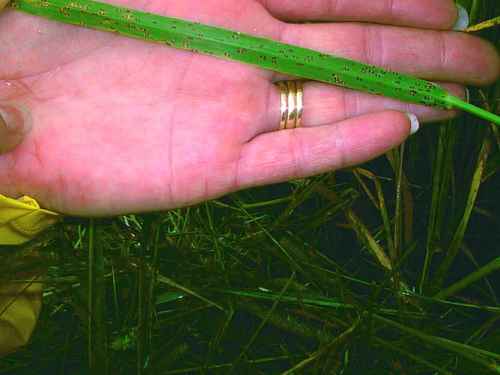
Figure 11. Purple eyespot (Cladosporium phlei) on timothy.
Photo courtesy of Gary Platford
Leaf streak is distinguished by lengthwise light brown streaks on the leaves, often along the margin (Figure 10). The infected leaves wither and die back from the tips. Leaf streak may affect forage quality and, in severe cases, seed yield.
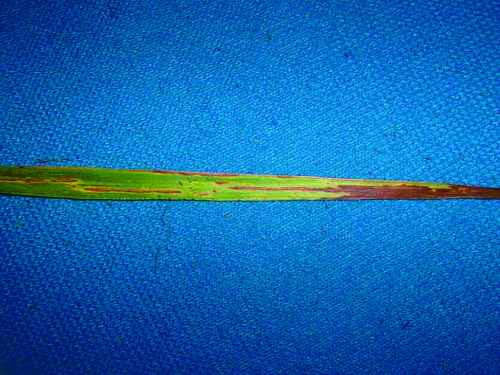
Figure 12. Leaf streak (Drechslera phlei) on timothy.
Photo courtesy of Gary Platford
Both diseases are carried on crop residue. Therefore, practices such as removing crop residue after harvest, grazing or burning as well as good fertility practices will help reduce disease levels.
The Manitoba Forage Seed Association conducted fungicide/disease trials on timothy seed crops in 2000 and 2001. Trials targeted leaf diseases such as purple eyespot and brown leaf stripe. Applications of fungicides in 2000 were made on June 7 and June 19. The first application was made before the development of the disease while the second application was made 7 to 10 days after the first application.
Disease incidence and severity in timothy was low in 2000. Cool temperatures at the beginning of the growing season favored the development of purple eyespot. Prolonged cool temperatures reduced the incidence of brown leaf stripe.
In 2000, the high rate of Nova, Tilt, Tilt/Tilt applications in the trials reduced the overall incidence of leaf disease at both sites (Table 16). The low rate of Nova and the Nova/Nova treatments did not reduce the incidence of leaf disease over the untreated control at both sites. At Beausejour, there were no significant differences in seed yield among the treatments. At Fisher Branch, all treatments yielded higher than the untreated control; however, only the split application of Tilt was significantly higher in seed yield than the check (Table 16).
Table 16. Effect of fungicides on timothy seed yields at Beausejour and Fisher Branch, Manitoba 2000 and 2001
| . | Beausejour | Fisher Branch |
| . | % leaf area infected* | Seed yield kg/ha** | % leaf area infected* | Seed yield kg/ha** |
| . | 2000 | 2001 | 2000 | 2001 | 2000 | 2001 | 2000 | 2001 |
| Nova 40W - 170 g/ha | 21 | 36 | 114a | 447a | 32 | 68 | 72a | 343a |
| Nova 40W - 340 g/ha | 9 | 34 | 126a | 420a | 23 | 65 | 72a | 278a |
| Nova 40W - 170 g/ha + Nova 40W - 170 g/ha | 12 | 35 | 99a | 477a | 37 | 58 | 60a | 286a |
| Tilt 250E - 0.8 l/ha | 7 | 36 | 136a | 432a | 21 | 55 | 70a | 269a |
| Tilt 250E - 0.8 l/ha + Tilt 250E - 0.8 l/ha | 7 | 27 | 128a | 474a | 30 | 54 | 80b | 237a |
| Flint - 247 g/ha | . | 33 | . | 415a | . | 57 | . | 297a |
| Folicur 432F - 292 ml/ha | . | 37 | . | 423a | . | 52 | . | 229a |
| Check | 13 | 40 | 122a | 466a | 31 | 64 | 55a | 229a |
In 2001, fungicide applications were made at Beausejour and Fisher Branch on June 6 and June 18. The incidence of disease was reduced by all treatments at Beausejour, although there were no significant differences in seed yield among the treatments (Table 15).
All treatments reduced the incidence of disease at Fisher Branch in 2001. Although there was a trend for improved seed yields following the application of fungicides, there were no significant differences in seed yield among the treatments. If used, fungicides should be registered for control of the disease in the particular crop. Always check labels for current registered uses.
Insects
Newly seeded timothy stands are susceptible to grasshopper, wireworm or cutworm damage, particularly if these insects were present in the field the previous year. Generally, established stands of timothy do not suffer from insect pests. Adequate moisture levels will usually improve the ability of newly seeded and established stands of timothy to tolerate insect feeding damage.
Grasshoppers
Grasshoppers are a chronic pest of grass seed fields, consuming leaves, stems and seed heads of grasses and other plants. Damage to the grass crop in the establishment year can cause almost total destruction, and the crop may require re-seeding. Even a well established grass seed field can be severely damaged by grasshoppers if feeding pressure is high.
Provincial governments issue annual grasshopper forecast maps predicting grasshopper infestations for the following year. Warm, dry weather in spring and early summer enhances the survival of grasshopper nymphs and will increase the likelihood of crop damage.
Planting non-preferred crops such as oats in wide strips around the edge of a field may deter grasshoppers from moving into that field. Alternatively, leaving a 5 m fallow, weed-free strip at a field perimeter may delay migration into the field. If there is an evident source of grasshoppers outside the field, controlling them in the areas where they hatch may be another option if the hatch sites are not ecologically sensitive.
An insecticide application should be made at about the time that the nymphs reach their 3rd instar, when they are 12 mm (0.5 inch) long (Figure 13). By that time, the hatch is usually complete.
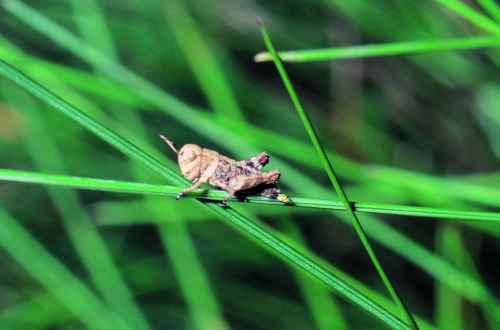
Figure 13. Third instar stage of a migratory grasshopper.
Photo courtesy of Agriculture and Agri-Food Canada
The use of bran bait rather than a foliar insecticide will decrease the contact of the insecticide with non-target species. However under extreme feeding pressure, bran bait may not provide enough efficacy to keep the damage below threshold levels.
Economic thresholds depend on the expected price of seed, the projected cost of control and the amount of crop damage a given population of grasshoppers can cause;
10 to 20 grasshoppers per m2 are a rough estimate of economic threshold in forage grasses. Under extreme outbreaks, repeat applications of insecticide may be necessary.
Glassy Cutworm
Glassy cutworm is a sporadic pest of timothy in western Canada (Figure 14). Adult moths of glassy cutworm have dark grey forewings with light grey and blackish markings and have two light grey spots near the center of each wing. Wing span is 30 to 40 mm. The moths fly from July to early September and lay eggs near the base of grasses. The larvae hatch soon after.
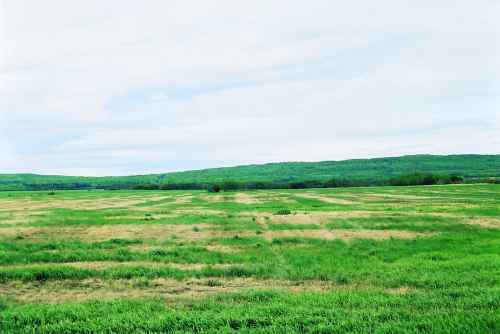
Figure 14. Grass seed field damaged by glassy cutworms.
The larvae have a translucent, greenish-white, smooth body with a reddish-brown head and neck shield. Mature larvae measure 35 to 40 mm in length (Figure 15). Pupae are reddish-brown, spindle shaped and roughly 30 mm in length (Figure 16). There is one generation per year.
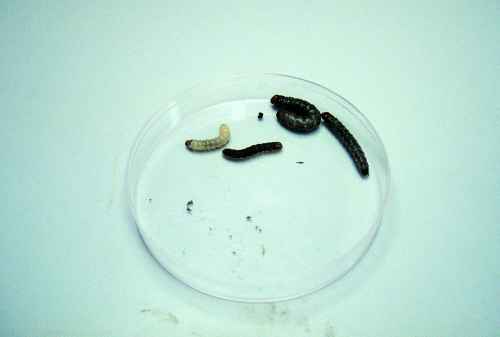
Figure 15. Glassy cutworm larvae.
Photo courtesy of Agriculture and Agri-Food Canada
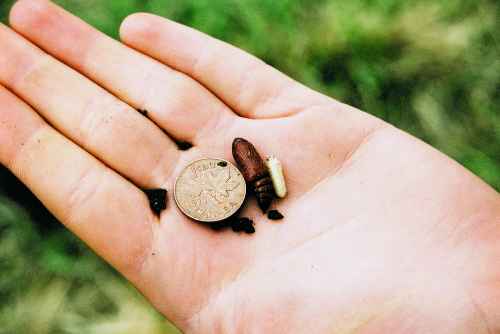
Figure 16. Reddish-brown glassy cutworm pupae.
The cutworm larva damages grass stands in the fall and the following spring by feeding on stems and crowns at or below the soil surface. Low and even moderate infestations may not cause visible damage if growing conditions are favorable. Drought appears to be an important factor favoring population increases of glassy cutworms.
Symptoms of glassy cutworm damage include poor growth or browning-off of above ground growth (Figure 14). Stands will usually show damage symptoms on higher areas of the field or in areas where chaff and/or straw have accumulated from the previous year.
Glassy cutworms rarely come to the soil surface during the damaging larval stage. It is, therefore, difficult to control this pest using foliar-applied contact insecticides since the larvae typically remain protected below the soil surface level. Currently, there are no economic thresholds for glassy cutworms in grass seed crops.
European skipper
The European skipper is a pest of timothy grass in Eastern Canada. It has recently been found in Manitoba, Saskatchewan and British Columbia. Larvae prefer to feed on timothy, but also feed on the leaves of several other grasses, including perennial ryegrass, meadow fescue, orchard grass and quackgrass.
Adult skippers are bright orange butterflies with narrow, dark wing borders and thin black lines along the main wing veins (Figure 17). Their wing span is about 25 mm. Larvae are greenish, with two white stripes extending along their backs. Fully grown larvae are about 25 mm long.
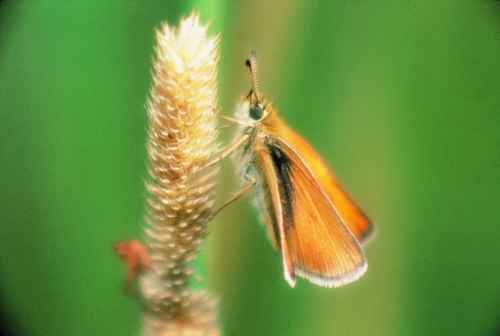
Figure 17. European skipper butterfly.
Photo courtesy of Ken Pivnick
European skippers overwinter in timothy and other grass fields as first instar larvae in the shell of the eggs. Larvae begin to emerge from the egg shells in early May (Figure 18). They crawl up grass blades and form tunnels by drawing the edges of the leaves together and tying them with silk. They develop through five instars and pupate on leaf debris, on the underside of leaves, or, if numbers are high, on the bare soil.

Figure 18. European skipper larva.
Photo courtesy of Ken Pivnick
Adult butterflies emerge by early July, mate and lay eggs in vertical rows on the inside of leaf sheaths of grasses, chiefly timothy. These eggs develop into larvae by late July, but the larvae remain within the shell until the next spring, so that there is only one generation a year.
Skipper larvae, the most damaging of which are the older, larger instars, chew on the grass blades on either side of their tunnels. If populations are high, many older larvae do not make tunnels, but feed on the exposed surface of the leaf.
They can completely defoliate a timothy field. If defoliation is extensive, larvae can also feed on developing seed heads. Defoliation is usually most severe by mid-June.
Legume flowers are preferred sources of nectar for the skipper butterflies. Therefore, mixing legumes and timothy provides an abundance of food and egg-laying material in the same field (Figure 19).

Figure 19. Timothy blade showing leaf roll containing European skipper larva and feeding injury.
Photo courtesy of Ken Pivnick
Because eggs can survive in baled hay, care should be taken when importing hay from skipper infested areas. Since eggs can also survive in association with seed and screenings, all timothy screenings from areas of skipper infestation should be destroyed.
Pesticides containing the microbial insecticide Bacillus thuringiensis kurstaki are effective in controlling larvae. Egg laying can be greatly reduced by removing cut grass as soon as possible after cutting. Skipper numbers can also be reduced in pastures containing timothy by heavy grazing in rotations of short duration.
Silvertop
Silvertop or silvertip is characterized by bleaching or whitening of the stem, beginning from the last upper node and extending to the tip of the seed head (Figure 20). While it occurs primarily in grass crops grown for seed such as fescues, bluegrasses, wheatgrasses and bromegrasses, silvertop is sometimes found in timothy in appreciable levels.
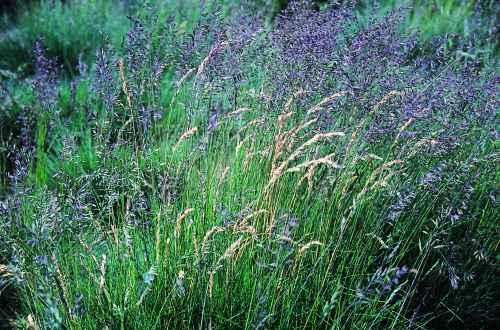
Figure 20. Grass field showing seed heads with silvertop (seeds sterile).
Bleaching of the head soon occurs after head emergence, and either no seed or sterile seed forms within affected heads. Once silvertop is noticed, no remedial action can be taken to reverse the seed head sterility in that growing season. Depending on seed prices and control costs, if silvertop levels reach 10 per cent or higher in a growing season, preventative measures should be considered for the next season.
The causal agents of silvertop have not been identified yet, but most feel that plant bugs are a principal cause. Preliminary work on fine-leaved fescues suggests insecticides can reduce silvertop if applied before head emergence. Burning of grass fields and very close mowing, with removal of the residue, have also decreased silvertop levels.
Insect control
Control of insects should be considered when numbers or damage exceeds economic thresholds. Unfortunately, these thresholds are not known for many insects, especially in crops of small acreages such as timothy for seed production. Cultural control measures such as inter-row cultivation may bring some soil borne insects to the surface where they are exposed to natural control agents. Residue burning may destroy insects and disease inoculum in the field.
If used, insecticides should be registered for control of the insect in the particular crop. Table 17 lists insecticides currently used in grass crops. The table is intended as a guide only. Always check labels for current registered uses.
Some insecticides, while registered in Canada, may not be allowed on products for export to certain countries. Contact the chemical company representative, your local agricultural office or the Pest Management Regulatory Agency in Ottawa for further information.
Table 17. Insecticides curently registered in Canada for control of insect pests in grasses
| Currently registered | Active ingredient | Pest controlled | Application use |
| Cygon/Laygon | Dimethoate | Grasshoppers | Pastures, wastelands, forages |
| Decis | Deltamethrin | Grasshoppers | Rangeland, pastures, roadsides |
| Diazinon | Diazinon | Grasshoppers | Rangeland, pastures, roadsides |
| Dibrom | Naled | Grasshoppers | Rangeland, pastures |
| Dipel | Bacillus thuring. | European skipper | Timothy |
| Eco Bran | Carbaryl | Grasshoppers | Forage grasses, pasture, range |
| Malathion | Malathion | Grasshoppers (young) | Hay, pasture |
| Matador | Cyhalothrin L | Grasshoppers | Unimproved pasture |
| Sevin XLR | Carbaryl | Grasshoppers | Forage grasses, pastures, range |
Harvesting
Special attention to details is essential during the harvest process. Most timothy seed losses occur because of shattering, improper windrowing and incorrect combine settings.
Swathing
Although timothy is easily shattered, it should not be swathed too early. It is usually ready to swath early-mid August when the tips of 5 to 10 per cent of the heads have shattered. The seed heads will have a tan color and the base of the seed head will be gold. This coloration corresponds to a 40 to 50 per cent moisture content based on the per cent moisture of the entire seed head.
Adjust the swather to lay heads into the center of the swath rather than flaring heads to the outside. Swathing at night and early in the morning will help reduce shattering. Do not swath wider than 4 m in very heavy crops. Bulky swaths are possible if the crop is cut high.
Combining
Allow five to fourteen days (depending on the weather conditions and the shattering ease of the variety) from swathing until combining. Combine settings will vary, but the following is a rough guideline for getting started.
Concave clearance should be from 3/16 to 3/8 in. (0.47 - 0.95 cm) at the front, and from 1/16 to 1/8 in. (0.16 - 0.32 cm) at the rear. Some producers will use a concave setting similar to wheat. Set the cylinder speed from 600 to 800 rpm. Settings will depend on field conditions and may have to be adjusted throughout the day (Figure 21).
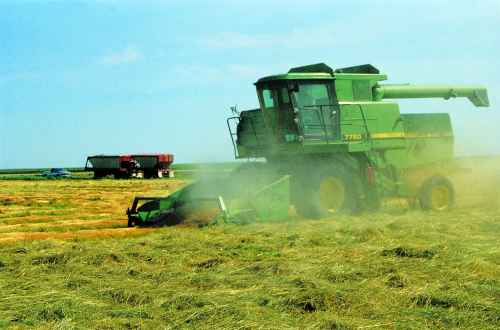
Figure 21. Combining a grass seed field.
Photo courtesy of Agriculture and Agri-Food Canada
Sieve and air separation adjustments vary greatly. The adjustable top sieves should be set to 1/2 in. (1.27 cm). The best separation occurs with high volume, low velocity air and a fan shaft speed setting of 350 to 400 rpm. A grass seed attachment fan is required to obtain this reduced fan speed. Increasing the fan speed will help obtain a cleaner sample. Taking a sample to a local seed company to conduct a dockage test will help determine whether the timothy is being threshed properly.
Drying the crop in the field is best, but for safe storage and delivery, the seed should be air dried to 12 per cent moisture as quickly as possible. If the weather is hot, a lower moisture content is required. Timothy seed will heat quickly above 12 per cent moisture and should be aerated immediately to cool it. Drying seed is difficult but has been done; the temperature during drying should not be more than 48°C.
Post Harvest Management
Removing residue
Crop aftermath is removed to improve field sanitation and reduce both disease and insect problems. The straw should be baled and removed immediately after combining. Mowing in the fall generally does not improve timothy seed yields the following year. A study in Manitoba showed there was no seed yield differences the following year among post-harvest residue treatments of straw removal, straw and stubble removal or fall burning.
Burning timothy is not a common practice, but growers sometimes do it every few years to reduce disease and insect problems and to lengthen the productive life of the stand. If burning is warranted, it is best to conduct the burn very early in the spring before new growth begins. Burning in May has reduced seed yields.
Feed value of straw bales
The protein content of timothy straw is lower than other grass seed straws but higher than cereals straws (Table 18). The acid detergent fibre (ADF) levels are lower and energy values higher than other grass and cereal straws. The quality of the straw will vary from field to field and year to year. Factors such as nitrogen fertility levels and weather conditions during harvest will affect the quality of grass seed straw.
Even though timothy straw is generally low in feed value, it may be used for feed or bedding. If used for feed, the straw should not be considered a complete feed for wintering beef cows, and it should be tested for feed quality and supplemented with other feeds.
Used in this manner, the nutritional requirements of cows can be met while maximizing the use of low quality roughage. This approach usually means supplementing rations with high protein feed. It is also important to check for feeding restrictions for the herbicides that were applied to the timothy.
Table 18. Nutritional value comparison of cereal and grass seed straws
| Straw | # of samples | Protein % | ADF % | TDN % | DEM cal/kg | NDF % |
| Barley | . | 4.6" | 46 | 47 | 2.05 | . |
| Wheat | . | 4.0" | 50 | 41 | 1.80 | . |
| Oats | . | 4.3" | 46 | 49 | 2.16 | . |
| Meadow bromegrass | 28 | 6.6 | 40.9 | 53.4 | 2.35 | 67.5 |
| Tall fescue | 30 | 8.4 | 39.9 | 56.7 | 2.51 | 63.7 |
| Creeping red fescue | 61 | 6.6 | 42.8 | 51.1 | 2.25 | 71.9 |
| Timothy | 35 | 4.9 | 38.2 | 56.8 | 2.50 | 66.5 |
| Smooth bromegrass | 10 | 5.0 | 36.9 | 59.3" | 2.61 | 62.4 |
Removing Timothy Stands
Traditional methods of terminating a timothy stand include plowing, rolling, a light discing and then a harrowing to prepare a smooth seed bed for the following annual crop.
An alternative method to tillage for terminating a timothy stand is to spray the field with glyphosate and direct seed an annual crop into the sod. Timothy is relatively easy to kill with glyphosate compared to other forage species (Table 19).
Table 19. Control of several grasses following the application of 1 L/acre of glyphosate in September 1993
| . | Visual control (%) |
| Grass species | June 1994 | September 1994 | July 1995 |
| Meadow fescue | 78 | 96 | 74 |
| Orchardgrass | 86 | 26 | 14 |
| Timothy | 90 | 96 | 74 |
| Crested wheatgrass | 91 | 91 | 68 |
| Meadow bromegrass | 90 | 65 | 30 |
| Smooth bromegrass | 68 | 40 | 51 |
| Creeping red fescue | 66 | 34 | 0 |
| Tall fescue | 96 | 94 | 86 |
It is recommended that producers apply no less than 1.5 to 2.0 L/acre of glyphosate as a post-harvest treatment once sufficient re-growth is present. Timothy plants are slow to re-grow following harvest and should have a minimum of 4 to 5 leaves present and be actively growing at the time of application.
Pre-harvest treatments of glyphosate on timothy seed crops are not recommended as this practice will reduce the germination of the seed significantly.
It is important to consider the timing of the herbicide application. A fall application of glyphosate to terminate the forage stand has several advantages over a spring application:
- improved forage and perennial weed control
- earlier seeding of the annual crop
- better seed bed conditions as there is a longer period of time for the existing sod to decay
- higher soil moisture levels
All these benefits result in higher annual crop yields when the stand is terminated in the fall compared to the spring.
Most cereal, oilseed and pulse crops can be direct seeded into sprayed timothy stands (Figure 22). The annual crop selected will depend on seedbed conditions, potential soil herbicide residues and in-crop herbicide options.
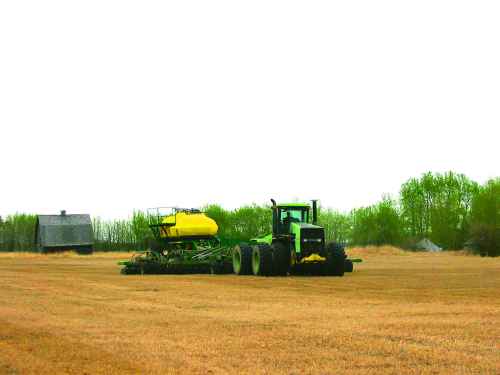
Figure 22. Direct seeding canola into a timothy stand sprayed out the previous fall.
Glyphosate tolerant canola now provides a good opportunity to use in-crop applications of glyphosate to help control any volunteer timothy or perennial weeds that may be present. Oats has also been shown to be a good crop to grow when direct seeded into sprayed out perennial grass stands.
Narrow openers are required when direct seeding into sprayed timothy stands. Disc openers will work better than hoe openers when direct seeding annuals into timothy sod. Soil tests should be taken to determine any limiting nutrients. Four to six-year-old timothy stands will be very deficient in nitrogen and most likely low in phosphorus, potassium and sulphur. High fertility levels will be required to grow a healthy crop following a timothy stand.
References:
Bailey, K.L., B.D. Gossen, R. Gugel and R.A.A. Morrall, (Editors). 2003. Diseases of Field Crops in Canada. Canadian Phytopathological Society, Saskatoon, SK. 290 pp.
Berg, C.C., A.R. McElroy and H.T. Kunelius.1996. Timothy. In Cool season forage grasses. Moser, L.E., D.R. Buxton. and M.D. Casler (eds.). Agronomy No. 34. pp. 643-664.
Canadian Hay Association. 1999. Timothy production handbook.
Cole, D. and A.L. Darwent.1990. Weed control in forage crops. Alberta Agriculture Agdex 120/640-1.
Darwent, A.L. and J.C. Drabble. 1996. Experiments in weed control of weeds in grass seed crops, 1971-1196. Agriculture and Agri-Food Canada. 53 pp.
Darwent, A.L., H.G. Najda, J.C. Drabble and C.R. Elliot. 1987. Effect of row spacing on seed and hay production of eleven grass species under a Peace River region management system. Can. J. Plant. Sci. 67:755-763.
Entz, M.H., S.R. Smith Jr., D.J. Cattani and A.K. Storgaard 1994. Influence of post-harvest residue management and cultivar on tiller dynamics and seed yield in timothy. Can. J. Plant Sci.74: 507-513.
Hay, R.K.M. and K. Pedersen. 1986. Influence of long photoperiods on the growth of timothy (Phleum pratense L.) varieties from different latitudes in northern Europe. Grass and Forage Sci. 41: 311-317.
Heide, O. M. 1994. Control of flowering and reproduction in temperate grasses. New Phytol. 128: 347-362.
Hill, M.J. 1980. Temperate pasture grass seed crops: Formative factors. p.137-151. In P.D. Hebblethwaite (ed.) Seed Production. Butterworths, London.
Loeppky, H.A., P.R. Horton, S. Bittman, L. Townley-Smith,
T. Wright and W.F. Nutall.1999. Forage seed yield response to N and P fertilizers and soil nutrients in northeastern Saskatchewan. Can. J. Soil Sci. 79:625-271.
Lopetinsky, K., D. Cole, O. Okuda and L. Darwent. 1989. Timothy seed production in Alberta. Agdex 127/15-2.
Manitoba Forage Seed Association. 1992. Forage seed production manual.
Otani, J., R. Byers, H. Phillip, L. Dosdall and C. Yoder. 2001. Glassy cutworm fact sheet.
Soroka, J. 1991. Insect pests of legume and grass crops in western Canada. Agriculture Canada Publication 1435/E. Ottawa, Ontario. 39 pp.
Technical input and review:
Bruce Gossen - Research Pathologist, Agriculture and Agri-Food Canada
Dan Cole - Weed Researcher, Alberta Agriculture Food and Rural Development
Dave Wong - Marketing Specialist, Alberta Agriculture Food and Rural Development
Garry Ropchan - Central Peace Conservation Society
Gerald Huebner - Forage Seed Specialist, Manitoba Agriculture Food and Rural Initiative
Henry Najda - Grass Seed Agronomist, Alberta Agriculture Food and Rural Development
Jennifer Otani - Entomologist, Agriculture and Agri-Food Canada
Jerome Lickacz - Agriculture Consultant
Juliana Soroka - Oilseed and Forage Entomologist, Agriculture and Agri-Food Canada
Michel Tremblay - Provincial Forage Specialist, Saskatchewan Agriculture, Food and Rural Revitalization
Michelle Watts - Manitoba Forage Seed Association
Nigel Fairey - Grass Seed Researcher, Agriculture and Agri-Food Canada
Sandra Burton - Manager, Peace Region Forage Seed Association
Prepared by:
Calvin Yoder - Forage Specialist, Alberta Agriculture Food and Rural Development
Funding provided by:


Factsheet content development contributed by:

Source: Agdex 127/15-2. June 2004. |
|